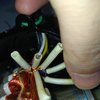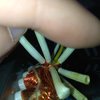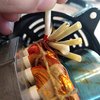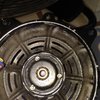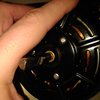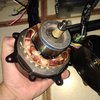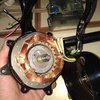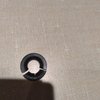Nick635csi . . . . .
Ist photo . . . shows end of motor and a 6 finger phospor bronze spring retainer which is pressing against and holding centered . . . .a porous sintered bronze bushing . . . a la . . .
Pickchur . . . .
Surrounding that bushing is a giant
THICK-THICK-THICK felt washer that has its large central hole pressing into the pheriphery of that outer part of that ovaloid shaped bronze bushing /bearing.
At final motor assembley day, that felt washer gets uber super soaked with thin low viscosity motor lube oil and a bit on the internal motor shaft end that spins within it..
A timely weeping/wicking of motor oil passing from felt to be absorbed by the sintered bronze bushing, automatically takes care of your lubrication needs, until any later years, where any neglect of re oiling the felt donut, will encouner the motor shaft to the bushing pores with overheating , lube breakdown and its filling with broken down oil "varnishes" / films / gums.
Photo 2 . . . gives a better view of the sintered bronze bushing surrounding the motor shaft. ? What is diameter of motor shaft ?
Photos 3 &4 . . . give a motor shaft end view that rides within the bushing . . . . and for NO EXTRA CHARGE ! you can see the inside end of the bushing in the background with its bushings clean
YELLOW felt packing surround.
There being no view of any surfactal scoring or discolor from oil overheating . . . likely due to actual minimum use of the unit to date .
As you might know, lubricating oils run
HOTTER"N HELL in our vehicles when mechanically
TAXED and in July- August heats . So the use of motor oil for
THIS appliction is sort of ruled out.
BUT . . I have found out that for the last 100 years or so , that my use of the RED dyed automatic transmission fluids of the 50-60-70's have worked well for this application, its viscosity is such that it readily weeps thru the porous bearing.
Its my usual 1 year PM on all of my motors of
THIS type . . . . just like day light saving times resets . . .except it being only once a year.
Thaaaassssit . . . . .
73's de Edd . . . .
The easiest way to make a fire with two sticks is first making sure that . . . . . one of them is being a match.
.
